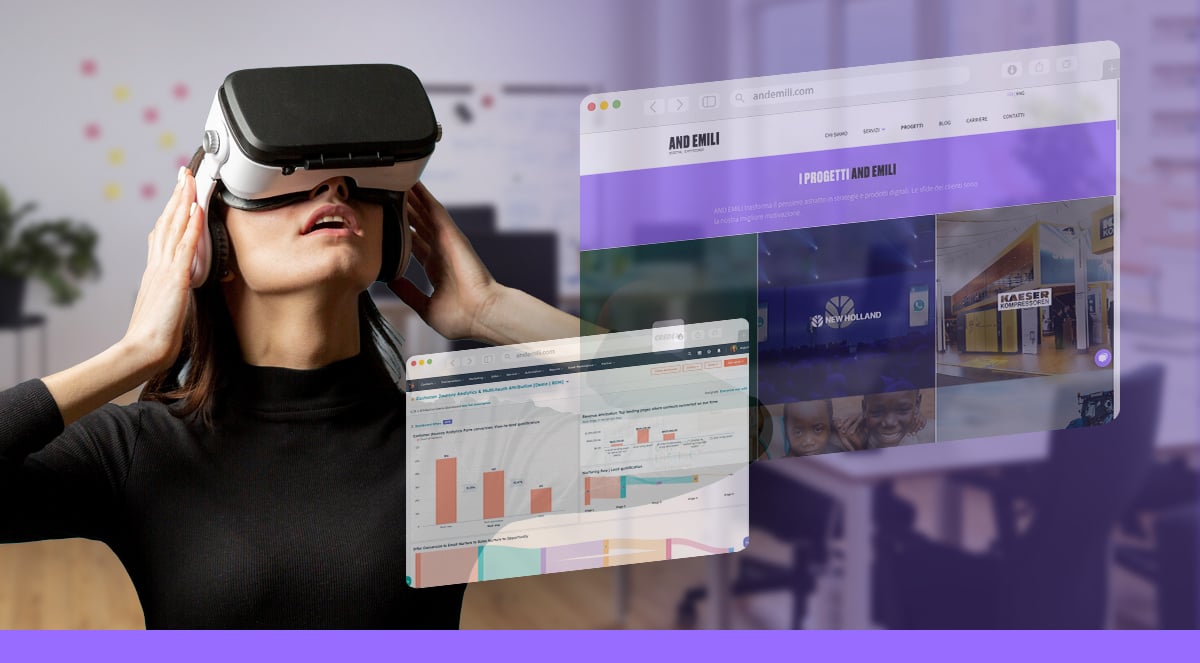Virtual and augmented reality: innovation in digital marketing

Virtual Reality (VR) and Augmented Reality (AR) are revolutionizing the ways in which brands and consumers interact, pushing the boundaries of what's possible in the digital world beyond anything previously imagined. These technologies not only allow users to fully immerse themselves in simulated experiences but also redefine the very foundations of digital communication.
Table of contents:
Introduction
Much more than mere technological novelties, VR and AR have deep historical roots that stretch back to the mid-20th century—as demonstrated by the "Sensorama Simulator" of 1962. This long evolutionary journey has seen VR and AR grow from simple curiosities into powerful marketing tools, capable of creating immersive and interactive experiences that were once only imaginable.
The Distinction Between Virtual Reality and Augmented Reality
Virtual reality transports users into entirely digital environments, creating scenarios where computer-generated images simulate reality to such an extent that they trick the human brain into believing it is actually inside that virtual world. This immersive and multisensory experience is made possible thanks to the advancement of computer technology.
Image entirely created by artificial intelligence (AI)
On the other hand, augmented reality enriches the real world with digital elements, integrating virtual information into our daily perception through devices such as smartphones and tablets. This fusion between real and virtual opens new paths for interaction with our environment, enhancing the user experience with a level of interactivity and personalization previously unexplored.
Both technologies represent not only a qualitative leap in digital innovation but also a new frontier in marketing, offering brands extraordinary tools to engage consumers in completely new and deeply engaging ways.
Exploring the Depths of Virtual Reality in Marketing
Having outlined the fundamental distinctions between VR and AR, it's time to dive into the peculiarities that make virtual reality an unparalleled tool in marketing. Two elements define the essence of VR: immersiveness, which transports the user beyond the boundaries of the real world, and interactivity, which enriches the experience by allowing direct and personal control of the virtual environment. Advanced devices like the Meta Quest or the Apple Vision are the keys to accessing these immersive experiences, specifically designed to break down the barriers between real and virtual.
Classification of Virtual Reality
According to Atria University, VR manifests in three main variants, each with its own peculiarities:
- Non-Immersive VR: Commonly encountered in video games, this version utilizes consoles or computers to generate virtual worlds confined to the screen. Here, the user remains anchored to the real world, interacting with the virtual environment through physical inputs like a mouse or controller. This mode keeps the user's awareness of their real environment intact while offering direct interaction with the digital world.
- Semi-Immersive VR: This experience offers a partial simulation, where the virtual environment extends beyond the screen without fully engaging the user's senses. Supported by high-resolution graphics and advanced sensors, semi-immersive VR is widely used in educational and training contexts, allowing for a rich and engaging virtual experience without total immersion.
- Immersive VR: At the pinnacle of the virtual experience, immersive VR integrates all senses, projecting the user into a highly realistic world where every event is experienced "first-hand." This level of immersion, which includes sight, hearing, and sometimes touch, is made possible by the use of cutting-edge technologies, such as dedicated headsets, sensory gloves, and specific suits. Flight simulators for pilot training represent one of the most emblematic examples of this technology, where the simulation reaches unprecedented levels of realism.
The Virtual Reality Revolution in Digital Marketing
Virtual reality (VR) is radically transforming the way brands interact with their audience, offering unique and immersive sensory experiences. Let's explore how VR fits into the digital marketing landscape and what advantages it brings:
Immersive Product Experiences
One of the most significant benefits of VR in marketing is its ability to create engaging brand experiences. Thanks to VR, companies can guide consumers through virtual tours of their products and services, breaking through the limitations of traditional presentations. These virtual journeys not only stimulate purchase interest but also provide a detailed understanding of the product's features and benefits, thereby reducing the risk of returns due to unmet expectations.
Indeed, 64% of returns in e-commerce are caused by products that do not meet consumer expectations. Minimizing returns not only reduces costs for companies but also increases customer satisfaction and contributes to sustainability by reducing waste.
An emblematic example comes from the automotive industry: Mazda used VR to allow potential customers to have an unforgettable experience on board its latest model, the CX-5, through a virtual test drive experience that takes place on the Longcross test track in Surrey, culminating in a spectacular stunt.
Image entirely created by artificial intelligence (AI)
This initiative highlights how VR can not only enhance consumer engagement but also provide a deeper understanding of the product in innovative and memorable ways.
Impact on E-commerce
VR has also revolutionized e-commerce, enabling retailers to offer an authentic and enjoyable shopping experience.
IKEA has revolutionized the furnishing experience with the launch of IKEA Place, an augmented reality (AR) app that uses Apple's ARKit technology to allow users to visualize IKEA furniture and accessories in full size directly in their space. With 98% accuracy, the app offers a realistic immersion allowing exploration of textures, light and shadow effects, and to try out different product configurations with a simple tap. Michael Valdsgaard, Head of Digital Transformation at Inter IKEA Systems, emphasizes the importance of augmented reality and virtual reality as a radical change for the retail sector, comparable to the impact of the internet in the past, but with a much faster adoption rate.
IKEA Place not only allows digitally placing IKEA products in a room but also captures the environment in-app and shares it as an image or video with friends, in addition to the option to purchase the products directly from the local IKEA website. The app also plays a key role in the launch of new product lines, demonstrating how technology has finally caught up with IKEA's ambition to redefine the retail experience for furniture, in line with its mission to create a better everyday life for people.
Virtual Events and Training
VR is proving to be a valuable tool in the organization of virtual events and in employee training, offering eco-friendly and cost-effective solutions that overcome barriers of distance and language. In content marketing, VR enhances engagement through immersive presentations of 3D images, models, and animations, making content more attractive and understandable.
In conclusion, VR is not just a technological innovation; it is a powerful marketing tool that opens new frontiers of interaction and understanding between brands and consumers, promising a future of digital marketing that is more effective and sustainable.
Enriching the Marketing Experience with Augmented Reality
AR represents an innovative frontier in marketing, capable of integrating digital elements into the real context through the use of advanced technologies. Thanks to sophisticated sensors, such as GPS, gyroscopes (which detect the change in direction of a moving object), and accelerometers (acceleration measuring devices present in mobile devices), AR applications are able to precisely locate users and tailor the digital experience to their surrounding environment.
Image entirely created by artificial intelligence (AI)
Microsoft identifies two main categories of AR:
- Marker-Based AR: This mode is activated through the recognition of specific images or markers, such as logos or QR codes, via the smartphone's camera. The markers serve as anchors to overlay digital content onto the physical world, creating a direct bridge between the user and digital information.
- Markerless AR: More advanced and versatile, this technology does not require predefined markers but uses recognition algorithms to identify objects or environmental features. Leveraging data from GPS, accelerometers, cameras, and compasses, it allows virtual elements to be placed anywhere in the surrounding environment, offering an unprecedented level of interaction and personalization.
In the digital age, the smartphone has become an essential tool through which consumers interact with brands and make purchasing decisions. AR thus emerges as a true revolutionary tool, capable of enhancing the brand and stimulating the acquisition of new customers and the generation of sales. By integrating augmented reality into marketing strategies, companies can offer unique and personalized experiences, transforming the way consumers perceive and interact with their products and services.
Innovative Applications of Augmented Reality in Digital Marketing
Augmented Reality (AR) opens new frontiers in digital marketing, enabling consumers to "try before they buy". This possibility radically transforms the purchasing journey, increasing the propensity to buy among potential customers. Thanks to AR, it's possible to experiment with makeup, clothing, or furniture directly in the home environment, without the need for physical interaction. This not only solves the problem of physical inventory but personalizes the shopping experience in ways previously unimaginable.
- Excellence Examples in the Use of AR
Sephora stands out as a pioneer in integrating AR into marketing strategies. This innovation extends the physical store experience to the digital realm, encouraging social media sharing and amplifying brand visibility.
Sephora's “Virtual Artist” tool allows shoppers to test lipstick shades, blush, foundation, eyeshadow, and more without ever having to leave the comfort of their home. Users can even share photos of themselves sporting different shades of certain products with their social media followers. This not only helps guide purchase decisions by soliciting comments from followers but also gives the brand greater visibility as users share the experience with others organically.
- Enhanced Tours and Product Experiences
AR offers the possibility to enrich physical places and products with digital elements, offering personalized experiences and additional information. A significant example is the StubHub app, which allows users to view the Super Bowl stadium in 3D, helping fans to choose the best available seats.
- Brand Identity Enrichment
Branding materials such as business cards and brochures can be transformed with AR, adding a level of interaction and information never seen before. This technology allows users to access additional content, such as videos or direct links, simply by scanning the material with a device.
- AR in the B2B Sector
In the B2B context, AR can revolutionize the sales process, facilitating the presentation of business proposals in a dynamic and interactive manner. This approach allows for greater customer involvement in product design, improving satisfaction and the working relationship.
Image entirely created by artificial intelligence (AI)
Winning Strategies for Implementing AR and VR in Marketing
To maximize the effectiveness of marketing campaigns based on augmented reality and virtual reality, it's crucial to adopt a strategic approach that focuses on three key pillars:
- Enhancing the Customer Experience: The core of using AR and VR should be to enrich the user experience. Focusing on how these technologies can not only improve customer interaction but also highlight the unique benefits of your offering is essential for creating successful campaigns.
- Intuitive Usability: Ensuring that immersive experiences are accessible and simple to use is crucial for their effectiveness. Technical complexity should not be a barrier for users; therefore, it is necessary to design experiences that are intuitive and can be enjoyed by as many people as possible.
- Tailored Personalization: The use of data to tailor AR and VR experiences to the specific needs and preferences of the target audience can significantly increase engagement and the relevance of campaigns. Personalization is the key to creating an emotional connection and a lasting memory in your customers.
Navigating Challenges in Implementing VR and AR Technologies
The transformative potential of Virtual Reality (VR) and Augmented Reality (AR) technologies comes with significant challenges and complications. It's crucial to address these issues from the start to develop strategies that not only maximize benefits but also minimize risks and obstacles. Let's explore some of the main challenges related to adopting these innovative technologies:
- Implementation Costs
Introducing VR and AR into your business requires a substantial investment in hardware, software, and content development. This financial burden can be a significant barrier for small and medium-sized enterprises, limiting access to these technologies primarily to organizations with more abundant resources.
- Technological Barriers
Despite technological advances, the effective use of VR and AR requires specific devices, such as VR headsets or smartphones and tablets compatible with AR. This requirement acts as an entry barrier for part of the market, making these technologies less accessible and attractive to some consumer segments.
- Privacy and Data Security
The collection of large volumes of user data, including behaviors and interactions, raises significant issues related to privacy and data security. It is imperative that companies implement robust data protection measures to build and maintain consumer trust, ensuring the security of personal and sensitive information.
Image entirely created by artificial intelligence (AI)
Conclusion: Towards an Innovative Future with VR and AR
Overcoming the challenges posed by Virtual Reality (VR) and Augmented Reality (AR) requires a methodical approach, involving meticulous planning, targeted investments in technology and content, and continuous monitoring of the impact on customer experience. The decision to opt for VR or AR should be driven by a company's specific marketing goals and the type of experience it intends to offer its consumers. Despite the obstacles, both technologies possess the innate capacity to transform the digital landscape, opening unexplored avenues to engage consumers in significantly new and richer ways, in an era characterized by relentless technological progress.
At the heart of technological innovation lies a crucial lesson for businesses and innovators: to consider virtual and augmented reality not as an end but as a powerful tool to achieve grand objectives. These technologies offer an almost unlimited field of possibilities, but only if approached with the right mindset. Seeing them simply as gadgets or novelties is a mistake that limits their potential and deprives us of their true transformative capabilities. In conclusion, VR and AR are much more than a passing trend: they are accelerators of progress and, if employed correctly, can push our strategies beyond the boundaries of the already known.
AND EMILI specializes in development and strategic consulting on digital channels.
Sources:
https://www.atriauniversity.edu.in/types-of-virtual-reality/#Application-of-Virtual-Reality
https://www.forbes.com/sites/ariannajohnson/2023/06/02/augmented-reality-ar-vs-virtual-reality-vr-whats-the-difference-and-how-do-they-work/#
https://bootcamp.cvn.columbia.edu/blog/augmented-reality-examples/
https://dynamics.microsoft.com/en-us/mixed-reality/guides/what-is-augmented-reality-ar/
This page has been translated using automated translation tools and artificial intelligence technologies. We strive to ensure that the content is accessible in multiple languages, but please be aware that the translation may not be perfect. If you have any doubts or need clarifications, please feel free to contact us.


